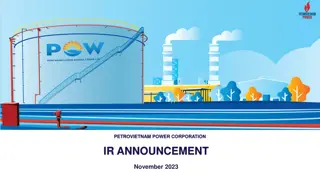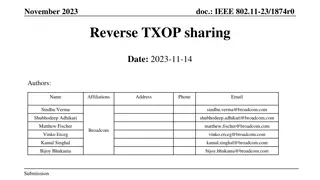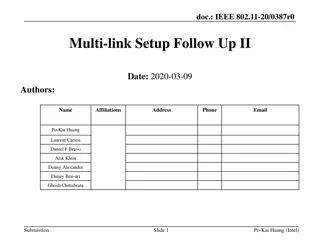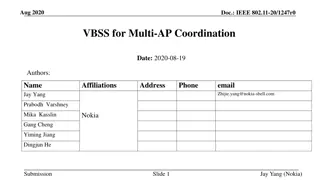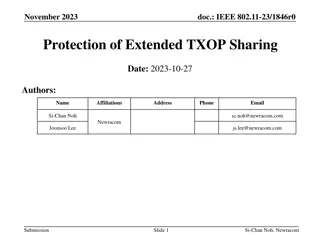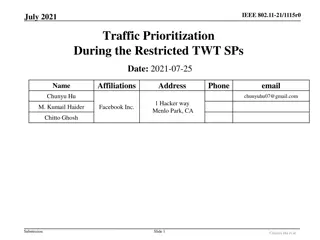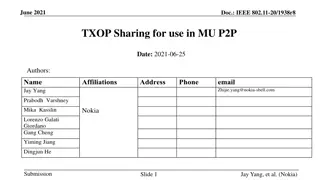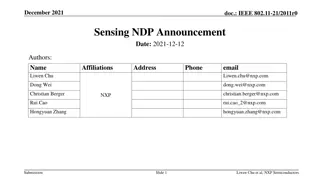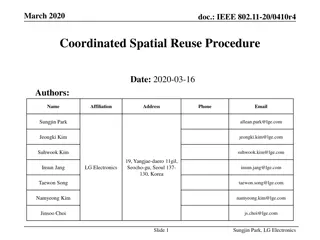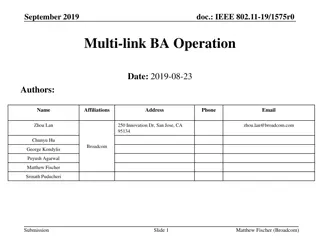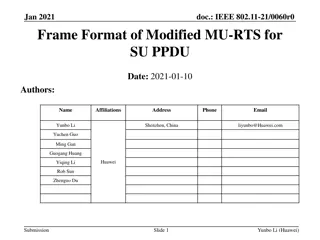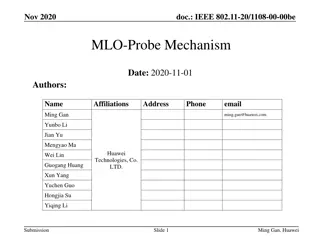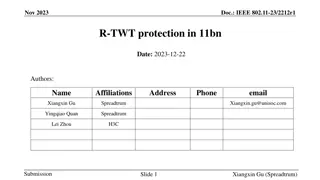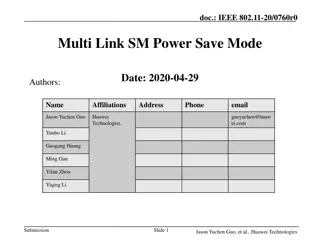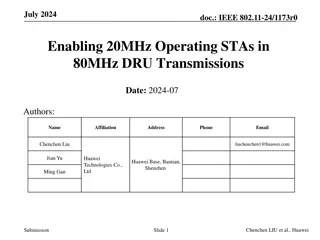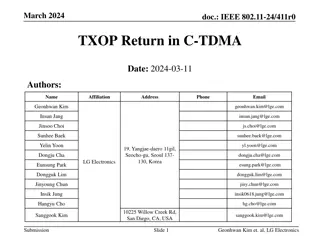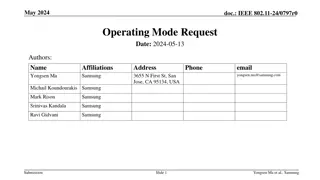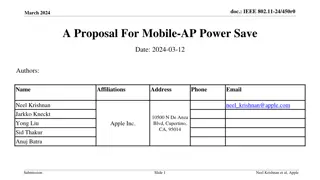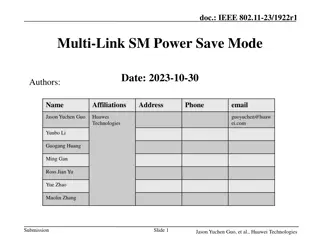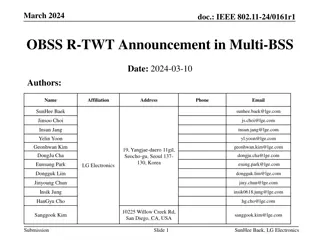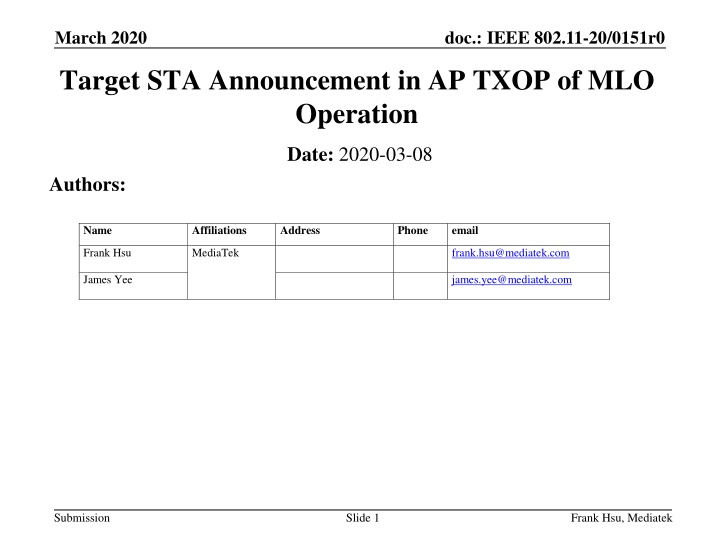
IEEE 802.11-20/0151r0 MLO Operations and STR: Target STA Announcement
Explore the issues arising when STAs are non-STR during an AP TXOP on one link in IEEE 802.11-20/0151r0. Discover solutions to enhance non-STR STA efficiency and multi-link benefits in MLO operations.
Download Presentation

Please find below an Image/Link to download the presentation.
The content on the website is provided AS IS for your information and personal use only. It may not be sold, licensed, or shared on other websites without obtaining consent from the author. If you encounter any issues during the download, it is possible that the publisher has removed the file from their server.
You are allowed to download the files provided on this website for personal or commercial use, subject to the condition that they are used lawfully. All files are the property of their respective owners.
The content on the website is provided AS IS for your information and personal use only. It may not be sold, licensed, or shared on other websites without obtaining consent from the author.
E N D
Presentation Transcript
March 2020 doc.: IEEE 802.11-20/0151r0 Target STA Announcement in AP TXOP of MLO Operation Date: 2020-03-08 Authors: Name Affiliations Address Phone email Frank Hsu MediaTek frank.hsu@mediatek.com james.yee@mediatek.com James Yee Submission Slide 1 Frank Hsu, Mediatek
March 2020 doc.: IEEE 802.11-20/0151r0 MLO Operations and STR Multi-link operation (MLO) A multi-link device can perform channel access (e.g., EDCA) on multiple wireless links independently Simultaneous Transmit Receive (STR) A multi-link device is capable of independent transmission and receive on each link Devices may not be able to perform STR due to hardware constraints or frequency band assignment In this contribution, we assume that AP is capable of STR and explore issues when STAs are non-STR during an AP TXOP only on one link Submission Slide 2 Frank Hsu, Mediatek Inc.
March 2020 doc.: IEEE 802.11-20/0151r0 Problem Statement (1/2) When AP grabs a TXOP only on a link (say, Link 1), and starts DL/UL frame exchange with some STAs on Link 1 During the TXOP Different frame exchange may happen on Link 2 For STR STAs, since Link 2 is independent from Link 1, they can freely use Link 2 When non-STR STAs monitor frame exchange on Link 1, their Link 2 connection is almost useless if eventually no frame exchange happens with AP on Link 1. These non-STR STAs downgrade to single link operation and are stuck on Link 1 during the TXOP Frame exchange with non-STR STAs? Link 1 APs TXOP Link 2 Submission Slide 3 Frank Hsu, Mediatek Inc.
March 2020 doc.: IEEE 802.11-20/0151r0 Problem Statement (2/2) Link 2 constraints of non-STR STAs Examples: 1. STA can not transmit on Link 2 when its Link 2 EDCA counter goes to zero and STA is decoding a Link 1 DL frame (it happens before STA knows the DL frames target STAs) 2. STA may lose a DL frame for it on Link 1 because before its UL frame on Link 2 ends, a DL frame on Link 1 arrives AP may schedule a DL frame for the STA before it decodes a UL frame from that STA on Link 2 Example 1 Example 2 DL UL Link 1 DL UL DL From other STAs Non-STR STA may lose the DL frame EDCA Counter ...3, 2, 1, 0 Link 2 EDCA Counter ...3, 2, 1, 0 UL Unknown DL frame RA yet, non-STR STA cannot access Link 2 for UL Submission Slide 4 Frank Hsu, Mediatek Inc.
March 2020 doc.: IEEE 802.11-20/0151r0 Ideas Knowledge of which STAs to have frame exchange during the Link 1 AP s TXOP helps improving non- STR STA efficiency if they can doze (suspend, or shutdown) Link 1 during the TXOP and use Link 2 regardless what happens on Link 1 Non-STR STAs capable of more links benefit more Link 1 APs TXOP Announcement from AP that which STAs will have frame exchange during the TXOP Link 2 Non-STR STAs expecting no traffic can doze Link 1 Non-STR STAs resume Link 1 Submission Slide 5 Frank Hsu, Mediatek Inc.
March 2020 doc.: IEEE 802.11-20/0151r0 Re-Cap of VHT TXOP power save Motivations A station can save power when it knows that there are no frames for it during a downlink MU-TXOP A non-AP VHT STA that is in TXOP power save mode may enter the doze state until the end of that TXOP when one of the following conditions is met: On receipt of a VHT MU PPDU, the STA determines that it is not a member of the group indicated by the RXVECTOR parameter GROUP_ID. On receipt of an SU PPDU, the STA determines that the RXVECTOR parameter PARTIAL_AID is not equal to 0 nor does it match the STA s partial AID and, etc Drawbacks for those STA allowed to enter doze state VHT MU PPDU from AP: any STAs do not belong to the MU group may go to doze mode VHT SU PPDU from AP: any STAs do not match their partial_AID may go to doze mode A single MU/SU PPDU may cause many STAs to go to doze mode VHT TXOP power save is not a good solution to the problem in MLO Submission Slide 6 Frank Hsu, Mediatek Inc.
March 2020 doc.: IEEE 802.11-20/0151r0 Scenario 1 MLO AP grabs a TXOP of a link and based on its buffers, it plans to load only DL frames to several target STAs An announcement frame of which STAs to have frame exchange during the TXOP is sent before DL data frames DL frames can be MU or SU STAs are not listed in the announcement frame make the link enter power save mode In the end of the TXOP, those STAs resume the link to regular operation Link 1 A. Frame DL MU PPDU ACK DL MU PPDU ACK Announcement frame of which STAs to have frame exchange during the TXOP Submission Slide 7 Frank Hsu, Mediatek Inc.
March 2020 doc.: IEEE 802.11-20/0151r0 Scenario 2 MLO AP grabs a TXOP of a link and it plans to load both DL and UL frames In addition to AP s own buffer, AP sends BSRP/BSR frames to inquiry STAs buffer status AP determines which STAs to have frame exchange (UL or DL) during the TXOP and send an announcement frame before data frames STAs are not listed in the announcement frame make the link enter power save mode In the end of the TXOP, those STAs resume the link to regular operation Link 1 BSRP BSR A. Frame TF TB UL MU PPDU ACK DL MU PPDU ACK Announcement frame of which STAs to have frame exchange during the TXOP Submission Slide 8 Frank Hsu, Mediatek Inc.
March 2020 doc.: IEEE 802.11-20/0151r0 Benefits DL TXOP power save for STAs not listed in the announcement frame Non-STR MLO STA to have no frame exchange during the DL TXOP owns a free link to use AP may do different level of estimation of STAs to be listed in the announcement frame Submission Slide 9 Frank Hsu, Mediatek Inc.
March 2020 doc.: IEEE 802.11-20/0151r0 Announcement Frame (Element) Content Ideas Broadcast on specific link(s) Announcement may contain different contents to save frame size Use similar indication as TIM Use AID AIDs of all STAs expected (not) to have frame exchange during the link s TXOP AIDs of non-STR STAs only expected (not) to have frame exchange during the link s TXOP (Save announcement size) Group ID if necessary 1 bit indicates not Instead of using a specific announcement frame, defining an element carried in a broadcast PPDU/frame is another implementation method More details are TBD Submission Slide 10 Frank Hsu, Mediatek Inc.
March 2020 doc.: IEEE 802.11-20/0151r0 Straw Poll 1 Do you support that during a DL TXOP of MLD AP, AP may send a broadcast announcement frame(element) carrying information about which STAs to have frame exchange with AP during the TXOP? Submission Slide 11 Frank Hsu, Mediatek Inc.
March 2020 doc.: IEEE 802.11-20/0151r0 BACKUP Submission Slide 12 Frank Hsu, Mediatek Inc.
March 2020 doc.: IEEE 802.11-20/0151r0 Supplemental Data DL TXOP occupied most of transmission time >80% Using EDCA to access channel, the traffic of the access category is allocated in advance Submission Slide 13 Frank Hsu, Mediatek Inc.

